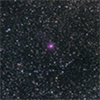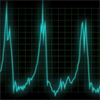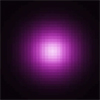CXC Home | Search | Help | Image Use Policy | Latest Images | Privacy | Accessibility | Glossary | Q&A
A Tour of GRS 1915+105
Quicktime MPEG
GRS 1915+105, or GRS 1915 for short, is a special system. Not only does it contain a black hole some 14 times more massive than the Sun in orbit with a companion star, it also has a heartbeat. Or, more exactly, it gives off X-ray pulses that resemble the pattern of a human heart, though on a much slower scale. By monitoring this system with NASA's Chandra X-ray Observatory and the Rossi X-ray Timing Explorer, astronomers were able to pick out a spike of X-rays every 50 seconds or so. Researchers have determined that this heartbeat is due to the ebb and flow of material as it circles the black hole. This result gives scientists more insight into how black holes regulate their intake and control their growth.
[Runtime: 00:55]
Quicktime MPEG
GRS 1915+105, or GRS 1915 for short, is a special system. Not only does it contain a black hole some 14 times more massive than the Sun in orbit with a companion star, it also has a heartbeat. Or, more exactly, it gives off X-ray pulses that resemble the pattern of a human heart, though on a much slower scale. By monitoring this system with NASA's Chandra X-ray Observatory and the Rossi X-ray Timing Explorer, astronomers were able to pick out a spike of X-rays every 50 seconds or so. Researchers have determined that this heartbeat is due to the ebb and flow of material as it circles the black hole. This result gives scientists more insight into how black holes regulate their intake and control their growth.
[Runtime: 00:55]
(Credit: NASA/CXC/Harvard/J.Neilsen et al & A.Hobart)
Simulation of GRS 1915's "Heartbeat"
Quicktime MPEG
This movie shows a simulation of the heartbeat variation of GRS 1915. It shows an X-ray point source varying with time, based on an average X-ray light curve of GRS 1915 obtained with RXTE. The period of the heartbeat variation has been sped up by a factor of 10 and four cycles of the variation are shown.
[Runtime: 00:20]
Quicktime MPEG
This movie shows a simulation of the heartbeat variation of GRS 1915. It shows an X-ray point source varying with time, based on an average X-ray light curve of GRS 1915 obtained with RXTE. The period of the heartbeat variation has been sped up by a factor of 10 and four cycles of the variation are shown.
[Runtime: 00:20]
(Credit: NASA/CXC/Harvard/J.Neilsen et al & A.Hobart)
GRS 1915's "Heartbeat" X-ray Variation
Quicktime MPEG
The heartbeat variation of GRS 1915 is shown here in a repeated cycle to emphasize the similarity between the X-ray light curve and an electrocardiogram. The period has been sped up by a factor of 40.
[Runtime: 00:20]
Quicktime MPEG
The heartbeat variation of GRS 1915 is shown here in a repeated cycle to emphasize the similarity between the X-ray light curve and an electrocardiogram. The period has been sped up by a factor of 40.
[Runtime: 00:20]
(Credit: NASA/CXC/Harvard/J.Neilsen et al)
Return to GRS 1915+105 (January 12, 2011)





